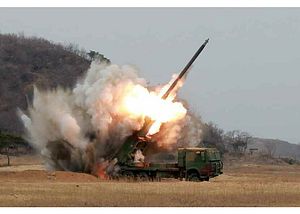South Korea’s Joint Chiefs of Staff have told the country’s lawmakers that they are studying the feasibility and utility of a new type of missile interceptor that would counter massive volleys of North Korean long-range artillery and rocket artillery fire.
According to the Hankyoreh, the Joint Chiefs told the National Assembly’s Defense Committee that they “we are considering the development of an interceptor system to counter concentrated enemy fire directed at important state and military facilities, including the War Command Headquarters and the Korean Air and Missile Defense (KAMD).”
“The Agency for Defense Development is developing key technology for directly and simultaneously intercepting North Korean long-range artillery rounds as they fall,” they added. The system would be similar to Israel’s Iron Dome interceptor network, which counters short-range rockets fired at populated areas. Indeed, the South Koreans considered procuring Iron Dome itself, but rejected it ultimately. The Joint Chiefs provided the following rationale:
Iron Dome is a weapon system that is appropriate for defending against sporadic rocket attacks by irregular military units such as Hamas. As such, it is inappropriate for a simultaneous long-range artillery attack by North Korea against the capital region.
The South Korean application does appear to be different: the Joint Chiefs make it clear that this system would protect valuable command-and-control and missile defense nodes from an artillery barrage, not population centers.
The system envisaged by South Korea would presumably require considerable research and development. Moreover, given the challenge of intercepting potentially hundreds of rocket artillery, the system would require a massive number of individual interceptors.
South Korea would need to be confident that it would be able to maintain an acceptable intercept rate against the incoming projectiles—a task that may require a prohibitively large investment in launchers and interceptors. Moreover, the battle management software required for a system like this may prove to be exceptionally complex as well. Existing missile defense systems can already have their systems overwhelmed by multiple targets.
Either way, the aspiration stated by the South Korean Joint Chiefs merits serious consideration. It is another example of South Korea pursuing indigenized damage limitation capabilities as part of its Korean Air and Missile Defnese (KAMD) project and other means. Whether it becomes reality is another question altogether. The endeavor may be insurmountably demanding and costly.
North Korea, meanwhile, continues to expand its arsenal of various multiple launch rocket systems (MLRS), which today comprise the KN09 (300mm rounds), KN12 (122mm rounds), and KN16 (240mm rounds) systems.

































